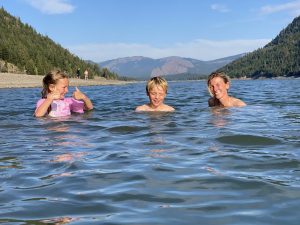 For our travels in the USA, there was an important decision we had to make, long before we set foot in the country: Do we apply for a visa that allows stays of up to 6 months or do we just use the 90 day ESTA? The former offers more flexibility but comes at a serious cost (150 euro per person) and a quite complex application process. The latter is cheap and very easy to get but puts quite a restriction on the planning. In the end we decided for the visa procedure and after filling out all kind of documents online, we found ourselves, queuing outside of the US embassy in the cold and rain, waiting for an interview which would determine if we were eligible for the visa or not. We got the visa! And we do not regret our choice at all. It gave us plenty of time to make our way down to Mexico. And after the ‘great Alaska rush’ summer we could really use this time time to slow down our travels.
For our travels in the USA, there was an important decision we had to make, long before we set foot in the country: Do we apply for a visa that allows stays of up to 6 months or do we just use the 90 day ESTA? The former offers more flexibility but comes at a serious cost (150 euro per person) and a quite complex application process. The latter is cheap and very easy to get but puts quite a restriction on the planning. In the end we decided for the visa procedure and after filling out all kind of documents online, we found ourselves, queuing outside of the US embassy in the cold and rain, waiting for an interview which would determine if we were eligible for the visa or not. We got the visa! And we do not regret our choice at all. It gave us plenty of time to make our way down to Mexico. And after the ‘great Alaska rush’ summer we could really use this time time to slow down our travels.
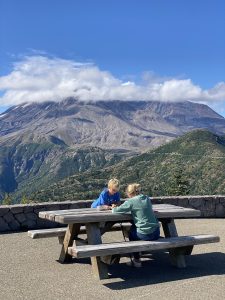 After our visit to Olympic National Park we decided to leave the Pacific coast and go to the interior (We did ear mark a trip down the Pacific Coast for future travels). We also decided not to go to Seattle (even though we had gotten a lot of recommendations for the city from other travelers) at this time but head straight for the mountains. Our first stop was at the Mount Saint Helens volcano to check out what was left of the mountain after an eruption in 1980 blew half the mountain away.
After our visit to Olympic National Park we decided to leave the Pacific coast and go to the interior (We did ear mark a trip down the Pacific Coast for future travels). We also decided not to go to Seattle (even though we had gotten a lot of recommendations for the city from other travelers) at this time but head straight for the mountains. Our first stop was at the Mount Saint Helens volcano to check out what was left of the mountain after an eruption in 1980 blew half the mountain away.
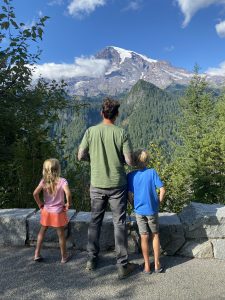 From there we continued to another volcano; Mount Rainier and the national park by the same name. Just like Olympic Park, this a park is a well-kept secret for international travelers but its beauty really blew us away. We visited during the labor day weekend and soon realised that it is not a secret for the inhabitants or Washington. We have never seen mountain trails so busy in all of our travels. The park is easily accessible from several major cities (Seattle, Tacoma) so it gets really busy during weekends. The proximity of these cities also makes the volcano, the most dangerous volcano in the USA. The danger is not so much in the in the lava but in the heavily snow-covered peak. An eruption of the volcano can trigger massive mudslides that will take out some heavily populated valleys and cities all the way to the coast.
From there we continued to another volcano; Mount Rainier and the national park by the same name. Just like Olympic Park, this a park is a well-kept secret for international travelers but its beauty really blew us away. We visited during the labor day weekend and soon realised that it is not a secret for the inhabitants or Washington. We have never seen mountain trails so busy in all of our travels. The park is easily accessible from several major cities (Seattle, Tacoma) so it gets really busy during weekends. The proximity of these cities also makes the volcano, the most dangerous volcano in the USA. The danger is not so much in the in the lava but in the heavily snow-covered peak. An eruption of the volcano can trigger massive mudslides that will take out some heavily populated valleys and cities all the way to the coast.
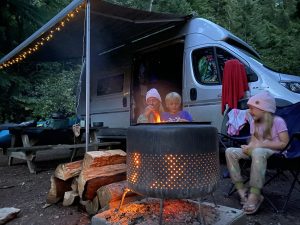 We continued further in land to the next state Idaho while enjoying some nice Indian summer weather. In Idaho, at the banks of Lake Coeur D’Alene, we finally took a couple of days off. It was time to relax, recharge and repair. We had planned to take a ‘day off’ (no driving & no tourist visits) at least one day and preferably two days per week. During the busy summer we had been very consistent in missing this objective. But now that autumn was coming and days were getting shorter, we wanted to follow nature’s rhythm and slow things down.
We continued further in land to the next state Idaho while enjoying some nice Indian summer weather. In Idaho, at the banks of Lake Coeur D’Alene, we finally took a couple of days off. It was time to relax, recharge and repair. We had planned to take a ‘day off’ (no driving & no tourist visits) at least one day and preferably two days per week. During the busy summer we had been very consistent in missing this objective. But now that autumn was coming and days were getting shorter, we wanted to follow nature’s rhythm and slow things down.
That also meant that we would need to start making more choices in what we would visit and what not. We had already started this exercise but a big choice came up for the next step. Head south east, straight to Yellowstone National Park or make a detour back north east to the Canadian border to visit Glacier National Park. It was a 300 km detour and we had already visited the Canadian part of the park in June. But on the other hand it was one of the parks that was recommended by most by people we met in the US. In the end we decided that this was one that we should not skip.
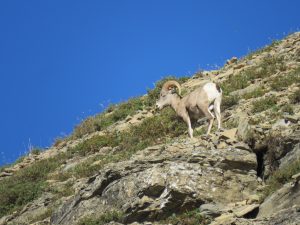 So a couple of days later, we found ourselves driving up the famous ‘Going to the sun’ road before sunrise, hoping we would be able to snatch a parking spot at Logan pass. One of the reasons why we came to Glacier national park was a couple of missing animals on our kids’ wildlife checklists: the bighorn sheep and the mountain goat. Both can be spotted in the park. When the kids heard a ranger explain that the best way to see them was on the ‘Highline’ trail, we had no choice but to walk this 21 km trail. Even before we got to the trailhead Leon spotted a bighorn sheep and 1 km into the hike we saw a mountain goat on a cliff above us. So both objectives were reached but still another 20 km to go. Luckily, the scenery along the whole hike was super impressive and we encountered a lot more animals: more bighorns and mountain goats, elk, marmots. But the most exciting was to see two grizzly bears that came running and playing down a mountain slope and over the trail just 100m in front of us. At the end of the day we were all completely exhausted. We have now reached the point where if the kids are exhausted, we are exhausted too… And we are very aware that pretty soon we will no longer be able to keep up. When we finally reached the parking lot, there was a nice surprise: a bighorn that was grazing just meters away from where we parked.
So a couple of days later, we found ourselves driving up the famous ‘Going to the sun’ road before sunrise, hoping we would be able to snatch a parking spot at Logan pass. One of the reasons why we came to Glacier national park was a couple of missing animals on our kids’ wildlife checklists: the bighorn sheep and the mountain goat. Both can be spotted in the park. When the kids heard a ranger explain that the best way to see them was on the ‘Highline’ trail, we had no choice but to walk this 21 km trail. Even before we got to the trailhead Leon spotted a bighorn sheep and 1 km into the hike we saw a mountain goat on a cliff above us. So both objectives were reached but still another 20 km to go. Luckily, the scenery along the whole hike was super impressive and we encountered a lot more animals: more bighorns and mountain goats, elk, marmots. But the most exciting was to see two grizzly bears that came running and playing down a mountain slope and over the trail just 100m in front of us. At the end of the day we were all completely exhausted. We have now reached the point where if the kids are exhausted, we are exhausted too… And we are very aware that pretty soon we will no longer be able to keep up. When we finally reached the parking lot, there was a nice surprise: a bighorn that was grazing just meters away from where we parked.
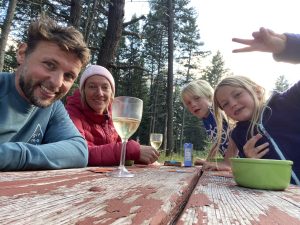 The next day, after another attempt to hike cut short by a storm, we celebrated the first birthday of the trip (Caro) on our campsite. Two black bears tried to join our little party, but were chased away by the ranger. On our way out of the park, we passed by the visitor center which had a very sobering display on climate change. A display with lights showed the disappearing glaciers in the park over the last 150 years. It is now predicted that by 2030 Glacier National Park will have no glaciers left…
The next day, after another attempt to hike cut short by a storm, we celebrated the first birthday of the trip (Caro) on our campsite. Two black bears tried to join our little party, but were chased away by the ranger. On our way out of the park, we passed by the visitor center which had a very sobering display on climate change. A display with lights showed the disappearing glaciers in the park over the last 150 years. It is now predicted that by 2030 Glacier National Park will have no glaciers left…
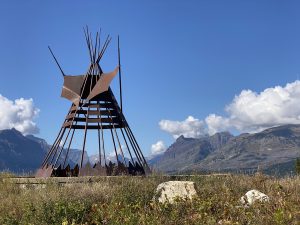 From Glacier, we started a very scenic drive south through the state of Montana along highway 89 towards Yellowstone National Park. For two days we drove through the Blackfeet Reservation and endless farmlands, where until 150 years ago plenty of Indian tribes used to roam, hunting bison.
From Glacier, we started a very scenic drive south through the state of Montana along highway 89 towards Yellowstone National Park. For two days we drove through the Blackfeet Reservation and endless farmlands, where until 150 years ago plenty of Indian tribes used to roam, hunting bison.
Somewhere half way through this drive, we passed through the town of Grand Falls, where we visited the Lewis & Clark museum. We had seen these two names pop up all over the place while driving inland from the Pacific coast in Washington. And now we finally learned more about this part of American history. Lewis and Clark were explorers that were mandated by president Jefferson to ‘explore the West’ after he negotiated the ‘Louisiana purchase’ with Napoleon. Their ‘official mission’ was to find a waterway to the west over the newly purchased US territory. It was very interesting to see how little was known about this part of the USA in 1803. The maps were pretty detailed on the Pacific coast and the East but everything in between was just a big blank on the maps. So in reality President Jefferson had no idea what he bought from Napoleon (who did not know what he was selling either) and Lewis & Clark’s real mission was to find out just that and start first diplomatic ties with the Indian people who had known this territory for ages.
We already experienced it in Glacier, but while looking for campsites in and around Yellowstone, we realized that September is still ‘high season’ in the major national parks.
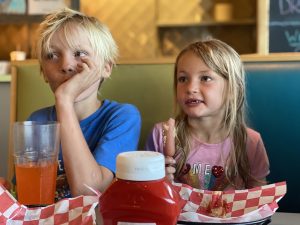 Not a single camping spot could be found for the next weeks. As we would be camping in the forests for at least 2 weeks, we decided to do a little splurge with a visit to some hot springs and a (by the kids) long anticipated visit to a ‘real American diner’.
Not a single camping spot could be found for the next weeks. As we would be camping in the forests for at least 2 weeks, we decided to do a little splurge with a visit to some hot springs and a (by the kids) long anticipated visit to a ‘real American diner’.

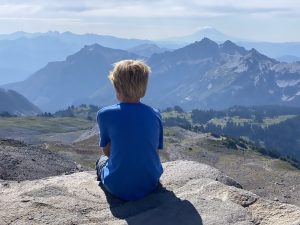
soms lastig, maar mooi!
soms lastig maar mooi!